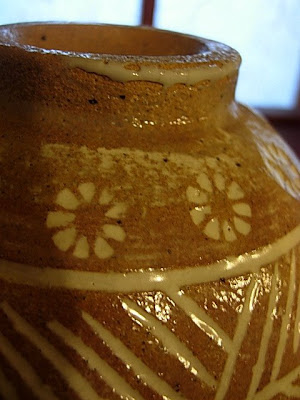

Not all ceramics are made the same. One of the biggest factors affecting the price of ceramics is whether a piece was fired in a wood burning or gas kiln.
Pieces from traditional wood burning kilns carry some value in Korea just because they employ methods that are 'traditional' and 'natural'. These factors also permeate all faucets of tea culture in Korea. The natural details created by pieces fired in a wood burning kiln such as flecks of ash, a rougher surface, and warping due to uneven heating are also highly valued. These details are not created by the hand of the artist but are imprinted by the hand of the wood burning kiln. These are factors that the ceramicist can't completely control. So in this way a measure of good luck is required to create a good work with a wood fired kiln. These pieces are valued by our eyes, but more so, our touch.
Gas fired works struggle to recreate the natural surface of ceramics. Not only is the process mechanized, art created in the gas kiln also exudes a certain 'artificialness' to it. The glossy finish and smooth, sleek look often characterize gas fired pieces. Although, to the western mind, these adjectives may sound like they should increase the value of a given work, in the wabi sabi tradition where perfection and symmetry are seen as unnatural, these pieces aren't so sought after.
Also costs of production must be taken into account. Wood burning kilns are expensive and labour intensive to make, but are much more expensive to actually run. Wood isn't cheap, especially in Korea. And especially when you consider how much lumber you would need to properly achieve the firing temperature. In gas kilns achieving, maintaining, and controlling the firing temperature is as easy as a turn of a dial, in wood burning kilns this is an art in and of itself. It takes not only more money to fire ceramics but much more time also.
In todays tough economic climate, one wonders if lesser known Korean ceramicist are switching from traditional wood firing to cost effective gas firing? Certainly one has heard of talented struggling ceramicists making the jump from wood burning to gas firing before.
One stumbled across some colourful teaware in a Daegu shop some time ago. Unable to determine the artist in question, one asked the store clerk who had produced such interesting, natural works. He went on to tell how the owner of the store discovered Lee Tae Ho.
As it goes, Lee Tae Ho had been artist for a while, but unable to crack the market, he only managed to make enough money to get by. His pieces were created from the naturalness of the wood fired kiln so naturally he charged appropriately for such works. At one point he realized that he wasn't getting anywhere selling these more expensive wood-fired pieces, in fact, he was barely making it day to day.
The store manager heard that Lee Tae Ho was having an exhibit so went to check out his work. She was perhaps a bit shocked to find out that his exhibition was at his 'new' home, an old abandon building, not the typical art gallery. On display he had many inexpensive gas fired pieces that almost pass as wood fired pieces.
Pictured are some interesting pots by a truly 'starving artist'.
Peace


















































